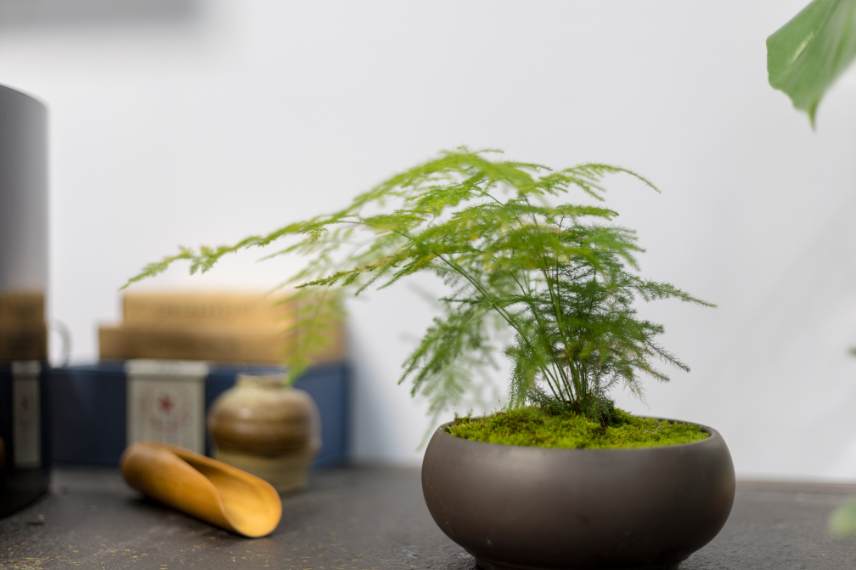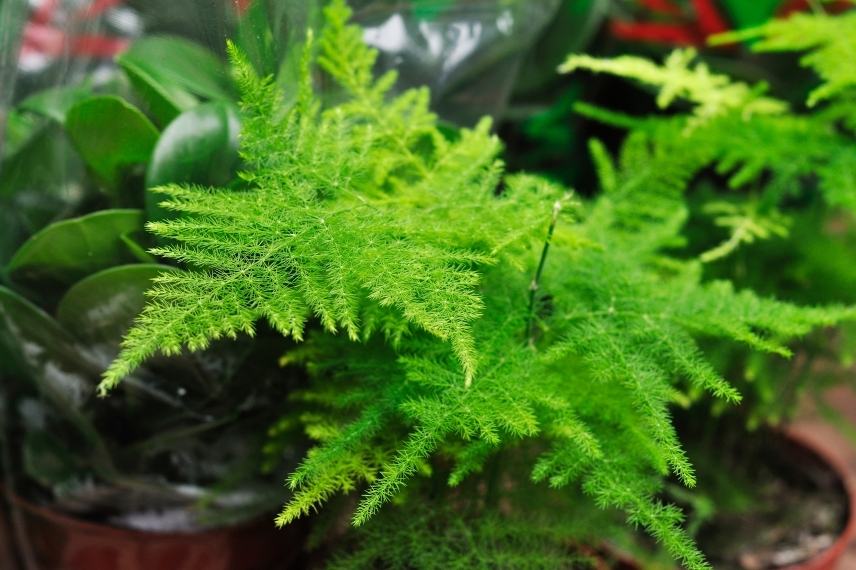
Indoor Asparagus Fern: How to Care for It Season by Season?
Watering, fertilising, repotting... everything you need to know throughout the seasons
Contents
With its very fine, light and feathery foliage, the asparagus is a highly popular young plant for interiors. Renowned for being robust and accommodating, it is ideal for beginners or those who believe they don’t have green fingers. However, despite its resilience, indoor asparagus requires seasonal care to maintain its vigour, as well as its delicate, finely cut foliage and the elegance of its airy habit.
Let’s explore how to care for asparagus or asparagus fern throughout the seasons, how to water correctly year-round, and the best time for pruning, fertilising or repotting.
For further reading: Indoor Asparagus: Growing and Care
What are the specific needs of asparagus?
Native to South Africa and Asia, where it grows naturally in humid and relatively bright undergrowth, the asparagus is a houseplant with specific requirements. Indoors, to achieve a vigorous plant with continuous growth, you need to recreate the characteristics of its natural habitat.
The indoor asparagus prefers a bright environment, but without direct sunlight, which could scorch its delicate foliage. A spot with filtered light from an east or west-facing window is ideal. That said, it can tolerate slightly shaded conditions, though its growth may slow down. It also requires a warm atmosphere, without being too dry.
When it comes to watering, the asparagus needs moist soil, without excess water. A well-draining medium, composed of a mix of houseplant potting compost, sand, and perlite, prevents the risk of root rot. Ambient humidity is also a key factor: the asparagus thrives in a humid atmosphere, requiring regular misting to prevent its fronds from drying out.

How to care for asparagus throughout the seasons?
The asparagus, a houseplant from the Asparagaceae family, requires different care depending on the season. It must adapt to varying light levels, temperatures, and humidity throughout the year.
How to Care for Your Asparagus in Spring?
For the asparagus, spring is a time of renewal. It’s essential to restart its growth after the winter dormancy period. Maintenance resumes to welcome spring under the best conditions and encourage new growth.
- Gradual increase in watering: now provide water once or twice a week to keep the soil fresh and moist, but not waterlogged. Remember to remove any excess water from the saucer or decorative pot. It’s best to use non-calcareous water at room temperature for watering. Rainwater is ideal.
- Resuming fertilisation: from March, it’s recommended to restart applications of liquid fertiliser for green plants, twice a month, to stimulate foliage development. Continue fertilising until September.
- Repotting: the asparagus has a tuberous root system and rapid growth. That’s why it’s advisable to repot every 2 years, in a slightly larger pot. Ideally, repot in spring, using a substrate made of houseplant compost, sand, and perlite, enriched with a little compost, on a layer of clay pebbles.
- Light pruning: after winter, it’s important to remove dried stems to encourage new shoots.
What Maintenance in Summer?
With rising temperatures, maintaining good hydration is essential.
- Increased watering: in summer, the asparagus grows quickly and consumes more water. Water regularly, about twice a week, ensuring the substrate stays moist but not saturated.
- Higher humidity: summer air is often dry. Misting the foliage with non-calcareous water can help, or placing the pot on a tray of water-soaked clay pebbles to increase humidity levels.
- Fertilisation: continue fertilising every two weeks.

Why is Autumn a Transition Period?
In autumn, the asparagus’s growth begins to slow. Adjust care to prepare for winter dormancy.
- Gradual reduction in watering: slowly decrease watering frequency, moving to once a week, then once every two weeks.
- Light: ensure the asparagus still receives good light, especially as days shorten. Move it to a brighter room, as long as temperatures stay above 15°C.
- Fertilisation: stop fertilising from September.
- Cleaning: remove yellowed or damaged leaves and regularly check the foliage.
What Specific Care in Winter?
In winter, the asparagus enters dormancy. Maintenance is minimal but still necessary.
- Very moderate watering: water sparingly, about once every two weeks, letting the substrate dry slightly between waterings. If the air is dry, mist the foliage with non-calcareous water.
- Placement: keep your asparagus away from heat sources (radiators, fireplaces, wood stoves…) and ensure temperatures don’t drop below 15°C. Also, avoid draughts.
Here are some tips for optimal care of your asparagus fern
Beyond seasonal care, here are some tips to keep your asparagus fern healthy and vigorous:
- Regularly air out the room where your asparagus fern is placed, especially in winter, as the air tends to be dry. In spring or summer, if you have a balcony, terrace, or garden, don’t hesitate to move your plant outside, in partial shade with morning sun or full shade.
- Watch closely for any signs of disease or parasitic infestations such as scale insects or spider mites, particularly in winter. At the first sign of trouble, treat promptly with natural solutions like black soap.
- At any time of year, never place your asparagus fern in direct sunlight, as this can scorch its foliage.
- Subscribe!
- Contents
































Comments